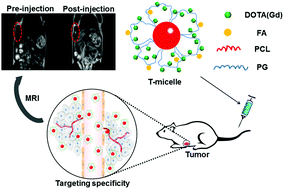A poly(ε-caprolactone)–poly(glycerol)–poly(ε-caprolactone) triblock copolymer for designing a polymeric micelle as a tumor targeted magnetic resonance imaging contrast agent†
Abstract
Gadolinium-based macromolecular contrast agents (CAs) with favorable biocompatibility, targeting specificity, and high relaxivity properties are desired for magnetic resonance imaging (MRI) of tumors. Herein, a novel triblock polymeric micelle based on poly(glycerol) (PG) and poly(ε-caprolactone) (PCL) was designed as a nanocarrier to fabricate a tumor targeted contrast agent (CA). Through conjugating gadolinium chelates and folic acid (FA) molecules to the PG block, a triblock-micelle contrast agent (T-micelle) formed from self-assembly demonstrated a low critical micelle concentration (CMC) of 6 mg L−1 and a hydrodynamic diameter of about 250 nm. Compared with small-molecule CAs, the T-micelle exhibited a higher longitudinal relaxivity (r1) of 14.71 mM−1 s−1. Moreover, the cellular viability assay revealed negligible cytotoxicity, and estimation of targeting capacity showed significant targeting specificity to tumor cells. In addition, MRI on tumor-bearing mice confirmed that the T-micelle could efficiently accumulate at the tumor region through targeting specificity and provide obvious contrast enhancement. Consequently, the T-micelle is a promising gadolinium-based macromolecular CA for tumor diagnosis.



 Please wait while we load your content...
Please wait while we load your content...